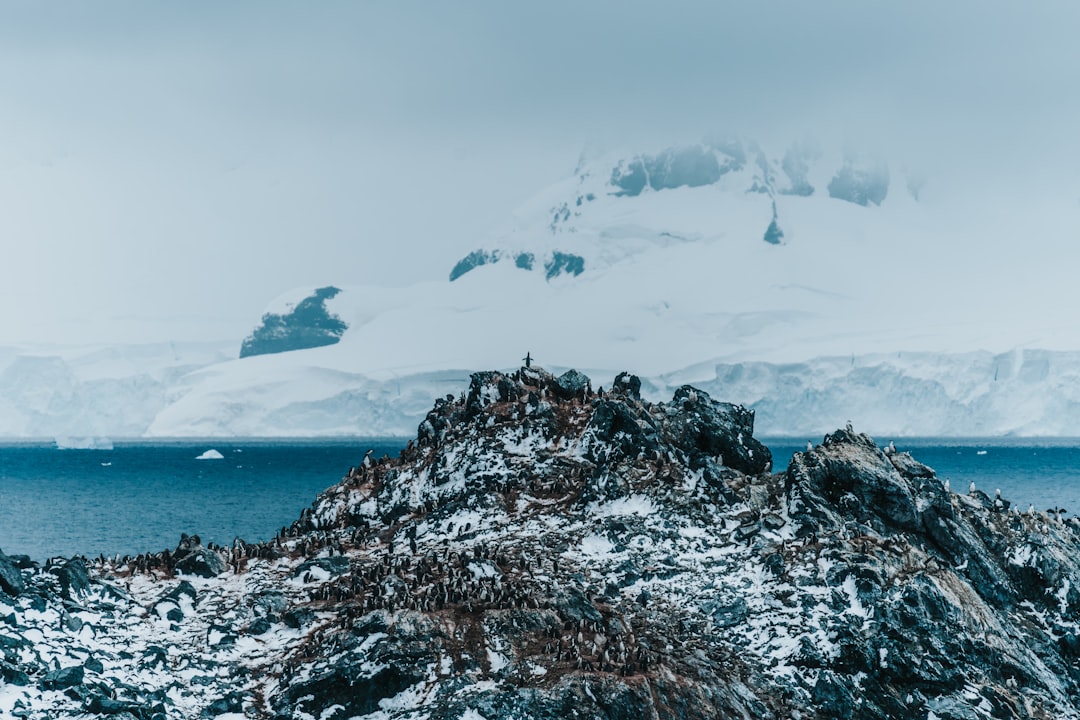The Drake Passage, a body of water situated between the southern tip of South America and Antarctica, is renowned for its tumultuous seas and significant role in global oceanic circulation. Named after the English explorer Sir Francis Drake, who navigated these waters in the late 16th century, the passage serves as a critical conduit for marine life and climate regulation. Stretching approximately 800 kilometers (500 miles) wide, it is often regarded as one of the most challenging maritime routes due to its unpredictable weather patterns and strong currents.
The passage not only connects the Atlantic and Pacific Oceans but also plays a pivotal role in the ecological and geological dynamics of the Southern Ocean. The Drake Passage is more than just a geographical feature; it is a complex interplay of oceanic and atmospheric systems that has fascinated scientists and explorers alike. Its waters are home to a diverse array of marine species, including whales, seals, and various seabirds, making it a vital area for biodiversity.
Furthermore, the passage’s unique position influences global weather patterns and ocean currents, underscoring its importance in understanding climate change and marine ecosystems. As researchers continue to study this remarkable region, they uncover the intricate relationships between tectonic activity, geological formations, and the rich biodiversity that thrives within its depths.
Key Takeaways
- The Drake Passage is a narrow body of water between South America’s Cape Horn and the South Shetland Islands of Antarctica, known for its strong winds and rough seas.
- Tectonic activity and plate tectonics play a crucial role in the formation and shaping of the Drake Passage, as the movement of tectonic plates has created the gap between South America and Antarctica.
- The formation of the Drake Passage is attributed to the separation of the South American and Antarctic plates, which began around 41 million years ago during the Eocene epoch.
- Tectonic activity continues to shape the geological features of the Drake Passage, including underwater mountain ranges and deep ocean trenches, influencing the region’s climate and biodiversity.
- The ongoing influence of tectonic activity in the Drake Passage has implications for future research, conservation efforts, and the understanding of climate change in the region.
Tectonic Activity and Plate Tectonics
Tectonic activity refers to the movement and interaction of the Earth’s lithospheric plates, which are responsible for shaping the planet’s surface over geological time scales. The Drake Passage is situated at a critical juncture where several tectonic plates converge, including the South American Plate, the Scotia Plate, and the Antarctic Plate. This convergence results in a dynamic environment characterized by seismic activity, volcanic formations, and the continuous reshaping of the ocean floor.
The interactions between these plates not only influence the geological landscape but also have far-reaching implications for oceanic currents and climate patterns. The study of plate tectonics has revolutionized our understanding of Earth’s geological processes. As tectonic plates shift and collide, they create various geological features such as mountains, trenches, and rift valleys.
In the case of the Drake Passage, the ongoing tectonic activity contributes to the formation of underwater ridges and basins that define its topography. This constant movement also leads to earthquakes and volcanic eruptions in surrounding regions, further emphasizing the significance of tectonic forces in shaping both land and sea. Understanding these processes is crucial for predicting future geological events and their potential impacts on marine ecosystems.
Formation of the Drake Passage

The formation of the Drake Passage is a tale of geological evolution that spans millions of years. Initially, during the late Cretaceous period, around 80 million years ago, the landmasses that would eventually become South America and Antarctica were connected by a land bridge. This connection allowed for the exchange of flora and fauna between the two continents.
However, as tectonic forces began to pull these landmasses apart, a rift formed that would eventually evolve into the Drake Passage. The separation was driven by the movement of tectonic plates, which created a gap that allowed ocean waters to flow freely between the Atlantic and Pacific Oceans. As time progressed, the widening of the Drake Passage had profound implications for oceanic circulation patterns.
The establishment of this waterway facilitated the development of the Antarctic Circumpolar Current, a powerful current that encircles Antarctica and influences global climate systems. The passage’s formation not only altered marine ecosystems but also played a crucial role in regulating temperatures across the Southern Hemisphere. The geological history of the Drake Passage serves as a testament to the dynamic nature of Earth’s surface and highlights how tectonic processes can shape entire oceanic regions.
Role of Tectonic Activity in Shaping the Drake Passage
| Metrics | Findings |
|---|---|
| Tectonic Activity | Significant tectonic activity in the Drake Passage region, including subduction zones and transform faults. |
| Seafloor Topography | Tectonic activity has led to the creation of deep basins and ridges, influencing ocean circulation patterns. |
| Volcanic Activity | Evidence of past and present volcanic activity, contributing to the geological shaping of the region. |
| Earthquakes | Frequent seismic activity due to the interaction of tectonic plates, impacting the local geology and seafloor morphology. |
Tectonic activity has been instrumental in shaping the physical characteristics of the Drake Passage. The ongoing interactions between tectonic plates have led to significant geological features such as underwater ridges, valleys, and fault lines that define this unique marine environment. The Scotia Arc, a series of islands and underwater ridges formed by tectonic uplift, plays a crucial role in influencing ocean currents within the passage.
These features not only contribute to the passage’s topography but also create habitats for various marine species. Moreover, tectonic activity has implications for sedimentation processes within the Drake Passage. As tectonic plates shift, they can uplift or subside sections of the ocean floor, affecting how sediments accumulate over time.
This sedimentation process is vital for understanding past climate conditions and marine biodiversity. By studying sediment cores from the ocean floor, scientists can gain insights into historical climate changes and how they correlate with tectonic events. Thus, tectonic activity is not merely a force of destruction; it is also a catalyst for ecological diversity and geological research.
Geological Features of the Drake Passage
The geological features of the Drake Passage are as diverse as they are fascinating. The passage is characterized by its deep-sea trenches, underwater ridges, and complex fault systems that reflect its tectonic history. One notable feature is the South Shetland Trench, which marks a significant geological boundary between the South American Plate and the Scotia Plate.
This trench is not only a site of intense seismic activity but also serves as an important habitat for various marine organisms. In addition to trenches, the passage is home to several islands that have emerged from volcanic activity associated with tectonic processes. The South Shetland Islands, for instance, are volcanic in origin and provide critical nesting sites for seabirds as well as breeding grounds for seals and penguins.
These islands contribute to the overall biodiversity of the region while also serving as natural laboratories for studying ecological interactions in extreme environments. The interplay between geological features and marine life in the Drake Passage underscores the importance of understanding these dynamics in addressing conservation challenges.
Impact of Tectonic Activity on the Climate of the Drake Passage

Tectonic activity has far-reaching implications for climate patterns in and around the Drake Passage. The movement of tectonic plates influences ocean currents, which play a crucial role in regulating temperatures across vast regions. The Antarctic Circumpolar Current, which flows through the passage, is driven by these tectonic interactions and helps distribute heat around the globe.
This current not only affects local weather patterns but also has implications for global climate systems. Furthermore, tectonic activity can lead to changes in sea level that impact coastal ecosystems and marine habitats. As landmasses shift due to tectonic forces, areas may experience subsidence or uplift, altering their exposure to ocean waters.
These changes can affect salinity levels, nutrient distribution, and overall marine biodiversity within the passage. Understanding how tectonic activity influences climate dynamics is essential for predicting future changes in marine ecosystems and developing effective conservation strategies.
Tectonic Activity and the Biodiversity of the Drake Passage
The biodiversity found within the Drake Passage is intricately linked to its geological history and ongoing tectonic activity. The unique underwater topography created by tectonic processes provides diverse habitats for a wide range of marine species. From deep-sea organisms adapted to extreme conditions to surface-dwelling species that thrive in nutrient-rich waters, the passage supports an array of life forms that rely on its dynamic environment.
Moreover, tectonic activity contributes to nutrient upwelling in certain areas of the passage, enhancing productivity and supporting rich food webs. This upwelling occurs when cold, nutrient-dense waters rise to the surface due to geological processes such as faulting or volcanic activity. As a result, regions within the Drake Passage become hotspots for marine life, attracting various species of fish, krill, and other organisms that form the foundation of Antarctic ecosystems.
The interplay between tectonics and biodiversity highlights how geological processes can shape ecological communities over time.
Human Exploration and Study of the Drake Passage
Human exploration of the Drake Passage has a long history marked by both adventure and scientific inquiry. Early explorers faced treacherous conditions while navigating these waters in search of new trade routes or territories. Today, modern technology has enabled researchers to study this challenging environment more comprehensively than ever before.
Oceanographic expeditions equipped with advanced instruments allow scientists to gather data on water temperature, salinity, currents, and marine life.
As scientists investigate how tectonic activity influences ocean dynamics and ecosystems within this region, they contribute valuable knowledge that informs policy decisions regarding environmental protection.
Collaborative efforts among international research teams have led to groundbreaking discoveries about marine biodiversity and climate resilience in one of Earth’s most remote areas.
Future Implications of Tectonic Activity on the Drake Passage
Looking ahead, understanding future implications of tectonic activity on the Drake Passage is essential for predicting changes in both geological features and marine ecosystems. As tectonic plates continue to shift over time, new underwater formations may emerge while existing ones evolve or erode away. These changes could alter ocean currents further impacting global climate systems.
Additionally, ongoing research into how climate change interacts with tectonic processes will be crucial for anticipating potential risks associated with rising sea levels or increased seismic activity in surrounding regions.
Conservation and Preservation Efforts in the Drake Passage
Conservation efforts in the Drake Passage are vital for protecting its unique ecosystems from threats such as overfishing, pollution, and climate change impacts. Various international organizations have recognized this importance by establishing marine protected areas (MPAs) aimed at safeguarding critical habitats within these waters. These MPAs serve as sanctuaries where marine life can thrive without human interference while also providing opportunities for scientific research.
Moreover, public awareness campaigns play an essential role in promoting conservation initiatives within this region. Engaging local communities alongside global stakeholders fosters collaboration toward sustainable practices that benefit both people and nature alike. By prioritizing conservation efforts in conjunction with ongoing scientific research into tectonic activity’s influence on biodiversity dynamics within this area—stakeholders can work together toward ensuring long-term ecological health for generations to come.
The Ongoing Influence of Tectonic Activity in the Drake Passage
In conclusion, tectonic activity continues to shape not only the geological landscape but also ecological dynamics within the Drake Passage—a region characterized by its rich biodiversity and complex interactions between landmasses and ocean currents. From its formation millions of years ago through ongoing seismic events today—these processes have profound implications for climate regulation as well as marine life sustainability. As researchers delve deeper into understanding how these forces interact with one another—new insights emerge regarding potential future challenges posed by both natural phenomena like earthquakes or volcanic eruptions alongside anthropogenic pressures such as climate change or pollution threats facing our oceans today—underscoring why continued exploration remains essential moving forward!
The formation of the Drake Passage, a significant oceanic gateway between the Atlantic and Pacific Oceans, has long intrigued geologists and oceanographers. This natural phenomenon is believed to have played a crucial role in the development of the Antarctic Circumpolar Current, which significantly impacts global climate patterns. For a deeper understanding of the geological events that led to the creation of the Drake Passage, you can explore a related article on the topic by visiting this page. This resource provides insights into the tectonic shifts and environmental changes that contributed to the passage’s formation.
WATCH NOW! Drake Passage: Earth’s Deadliest Waters Revealed
FAQs
What is the Drake Passage?
The Drake Passage is the body of water between the southern tip of South America and the northern tip of the Antarctic Peninsula. It connects the Atlantic and Pacific Oceans.
What caused the formation of the Drake Passage?
The formation of the Drake Passage is primarily attributed to the break-up of the supercontinent Gondwana around 30 million years ago. This geological event led to the separation of South America from Antarctica, creating the Drake Passage.
How did the Drake Passage affect ocean currents and marine life?
The Drake Passage is known for its strong and continuous westerly winds, which drive the Antarctic Circumpolar Current. This current plays a crucial role in regulating global ocean circulation and has a significant impact on marine life in the region.
What are the environmental implications of the Drake Passage?
The Drake Passage serves as a natural barrier that isolates the Antarctic continent, influencing its climate and ecosystem. It also plays a role in the exchange of heat and carbon dioxide between the ocean and the atmosphere, making it an important area for climate research.
How does the Drake Passage impact maritime travel?
The Drake Passage is notorious for its rough seas and challenging sailing conditions, earning it the nickname “the roughest sea in the world.” It presents a significant obstacle for maritime travel between South America and Antarctica.
